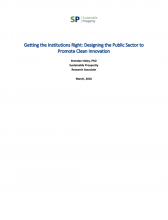June 21, 2016
Canada’s current economic state of affairs has been described as a “low-innovation equilibrium”. While Canada has an educated workforce and strong scientific capabilities, we fall short in creating new knowledge-based firms and industries. There is a growing policy consensus on the need for more strategic and targeted approaches, capable of grappling with innovation problems and opportunities in particular sectors, regions, and technological areas. While Canada confronts its general innovation problem it must also face other challenges, amongst them climate change and environmental degradation.
In this century, countries that are able to improve resource efficiency and reduce environmental impacts are likely to be rewarded in global markets. A transition towards sustainable development could create a mix of external pressures, windows of opportunity, and societal mobilizations that trigger an escape from Canada’s state of low-innovation equilibrium. However, unless we develop new policy approaches clean technology sectors could fall into Canada’s general pattern of innovation underperformance.
This report grapples with the question of how to get the institutions right to implement effective clean innovation policy by drawing on lessons from the academic literature and four case studies.




